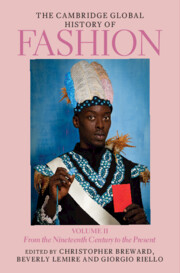Book contents
- The Cambridge Global History of Fashion
- The Cambridge Global History of Fashion
- The Cambridge Global History of Fashion
- Copyright page
- Contents for Volume II
- Figures for Volume II
- Maps for Volume II
- Table for Volume II
- Contributors for Volume II
- Preface
- Part IV Fashion, Modernism, and Modernity
- 21 Fashionable Masculinities in England and Beyond
- 22 Fashion in Capitalism
- 23 Fashion and Youth in Western Societies
- 24 Fashion and Time in China’s Twentieth Century
- 25 The Totalitarian State and Fashion in the Twentieth Century
- 26 Hollywood and Beyond
- 27 Fashion and Non-Fashion Cultures
- 28 Fashion and Hypermodernity
- Part V Fashion, Colonialism, and Post-Colonialism
- Part VI Fashion Systems and Globalization
- Index
- References
27 - Fashion and Non-Fashion Cultures
from Part IV - Fashion, Modernism, and Modernity
Published online by Cambridge University Press: 04 August 2023
- The Cambridge Global History of Fashion
- The Cambridge Global History of Fashion
- The Cambridge Global History of Fashion
- Copyright page
- Contents for Volume II
- Figures for Volume II
- Maps for Volume II
- Table for Volume II
- Contributors for Volume II
- Preface
- Part IV Fashion, Modernism, and Modernity
- 21 Fashionable Masculinities in England and Beyond
- 22 Fashion in Capitalism
- 23 Fashion and Youth in Western Societies
- 24 Fashion and Time in China’s Twentieth Century
- 25 The Totalitarian State and Fashion in the Twentieth Century
- 26 Hollywood and Beyond
- 27 Fashion and Non-Fashion Cultures
- 28 Fashion and Hypermodernity
- Part V Fashion, Colonialism, and Post-Colonialism
- Part VI Fashion Systems and Globalization
- Index
- References
Summary
The term ‘fashion cultures’ invites consideration of how dress is both a form of differentiation and also a way of seeking commonalities. Fashion may be an explicit medium through which people form connections to others or reject them in the articulation of shared ‘anti-fashion’-style groupings. This chapter will consider how fashioning is a material process through which individuals construct shared (and individual) styles in relation to each other, in specific cultural contexts. There are many academic approaches to fashion which coexist with everyday understandings of what fashion is from the perspective of clothes wearers; in this chapter I unpack some of the complexities and ambiguities within shared clothing cultures that emerge from everyday wearers’ understandings of fashion and the impact upon fashion practices.
- Type
- Chapter
- Information
- The Cambridge Global History of FashionFrom the Nineteenth Century to the Present, pp. 969 - 993Publisher: Cambridge University PressPrint publication year: 2023



